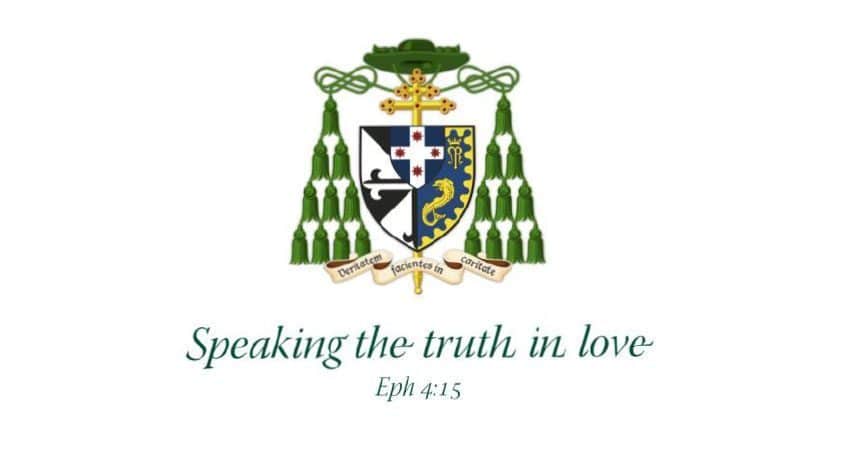HOMILY FOR THE RITUAL MASS OF DEDICATION OF A CHURCH AND ALTAR

SHRINE OF OUR LADY OF MT CARMEL, WATERLOO, 19 APRIL 2024
In The Tide Rises, The Tide Falls the nineteenth-century American poet, Henry Wadsworth Longfellow, a contemporary of John Bede Polding, used the imagery of an adventurer like Polding crossing oceans and lands to visit various communities, as a way to reflect on time and mortality.
The tide rises, the tide falls,
The twilight darkens, the curlew calls;
Along the sea-sands damp and brown
The traveller hastens toward the town,
And the tide rises, the tide falls.
By bookending each stanza with the lyrical “the tide rises, the tide falls”, Longfellow intimates that time waits for no one. All our experiences in life, the changes we go through as individuals and communities, the progress we make and the footprint we leave behind, all hang in the air like a gloomy cloud.
Darkness settles on roofs and walls,
But the sea, the sea in the darkness calls;
The little waves, with their soft, white hands,
Efface the footprints in the sands,
And the tide rises, the tide falls.
This past week, only a few miles away in Bondi Junction, many experienced the darkness call and the footprints effaced, as innocent shoppers, even a baby, were attacked. Soon after, in Wakeley, a bishop was stabbed in church, along with a priest, and police bore the brunt of recriminations. In the face of “man’s inhumanity to man”, the human heart cries out: why do people do such things? Why does God permit them? Why do the innocent suffer? We are confronted with human mortality, vulnerability, sin.
Longfellow wrote his poem knowing that he too would be here one minute and gone the next, his footsteps on the shore erased, as time ebbs and flows.
The morning breaks; the steeds in their stalls
Stamp and neigh, as the hostler calls:
The day returns, but nevermore
Returns the traveller to the shore,
And the tide rises, the tide falls.
The poet like the hostler calls, even from the grave. Polding the traveller returns no more. Our predecessors in Waterloo have come and gone. So will we. For some, life is “nasty, brutish and short,” as Thomas Hobbes put it; for others, it’s easier; but there’s no rhyme or reason to it. Has Christian faith any wisdom to offer?
In our epistle, we heard consoling words: “Jesus Christ is the same yesterday, today, and forever” (Heb 13:8). God-made-man stares down the darkness of the human heart and the transience of human existence. The tattoos of His passion are not scrubbed out on the shore, for they are signs of His eternal love. But they are glorious now, and that resurrected body is a pledge of redemption, purpose, eternal life.
But Jesus is not just concerned about our afterlife: here and now He offers us a share in His sacrifice at the altar, spiritual nourishment for our bodies and souls, a foretaste of the heavenly banquet. The new altar we consecrate tonight and the old shrine that contains it are to this one end: that we might, in the words of the Gospel, worship the Father in spirit and truth (Jn 4:19-24)—in the spirit who is the Holy Spirit and the Truth who is Jesus—and so, even now, share in His Easter life through “the Breaking of the Bread” (Acts 2:42-47).
So, we come to the Rites of the Consecration of a Church and Altar. She’s left it rather late, but 165 years after she began, we’ll witness this unbaptised girl completing her Christian initiation. At the start of Mass, we ‘baptised’ her, as it were, sprinkling walls and altar with baptismal water, recalling the blessing by Archbishop Polding. Now, she is instructed through a mystagogia of readings and homily: so are you listening Altar?
Next, we profess our faith with our stony catechumen and pray for her, invoking the saints as we do for catechumens on Easter night. Then comes her ‘Confirmation’, as we anoint her with Sacred Chrism, calling down the fiery Spirit. The beautiful prayer recalls our family history and expresses our hopes for her future. After Baptism and Confirmation she will be clothed in Easter white and candles will tell of her enlightenment. Only once these rites have been completed can I give the altar the customary Kiss of Peace, for only then will she be a Christian ready to celebrate her first Holy Communion…
Stone and fire, oil and incense recall ancient sacrifices that foreshadowed Christ. But tonight we trace crosses in the middle and all four corners of the altar to recall the sacrifice that supersedes all ancient rites, and as the tide of life rises and falls we know the sacrifice of the cross is our pass key for eternity.
Dear brothers and sisters, I pray that in this soon-to-be-dedicated church and on this soon-to-be-consecrated altar, the grace of God’s all-encompassing love, balm for every hurting heart, will be generously poured out on all those who come to this truly beautiful shrine. Through the intercession of Our Lady of Mt Carmel may this city on a hill, this lamp on a lampstand, inspire all who see her and draw them closer to the light of eternity.
INTRODUCTION TO THE RITUAL MASS OF DEDICATION OF A CHURCH AND ALTAR – SHRINE OF OUR LADY OF MT CARMEL, WATERLOO, 19 APRIL 2024
Welcome to the Shrine of Our Lady of Mt Carmel, Waterloo, part of City South Catholic Community, for today’s Ritual Mass of Dedication of a Church (already in use) and of an Altar, following recent restoration works.
According to tradition, whilst caught in a terrible storm at sea off Fremantle and fearing for his life, Archbishop John Bede Polding promised Our Lady of Mt Carmel he would build her a church on the highest hill he could find in Sydney, if she protected him.[i] She did and he did too. He settled on this hill, celebrated in the Catholic newspaper of the time as the most beautiful and commanding site for a house of worship in the world.[ii]
When Polding arrived here to lay the foundation stone in 1859, there were tears “in many an eye” and cries of ‘God bless him’ uttered by young and old. After assuming his pontificals, the archbishop led the clergy and boys in their chants and lowered the stone into place. There were further benedictions, hymns and processions, then “an impressive exhortation” by Polding.[iii] In the subsequent 165 years, the parish, school and city grew and evolved a great deal. And when we celebrated together the 160th anniversary there was already talk of improvements in the air.
Tonight, we mark another milestone for this church, blessed many years ago while still incomplete but never ritually consecrated, as we finally dedicate the church along with the new altar. The Rite is one of the most ancient and beautiful of our Church but only a few fortunate Catholics have ever seen it. Like the stages of initiation of a new Christian, you will witness the ‘Baptism’ of church and altar with holy water, their ‘Confirmation’ with sacred Chrism, and the altar’s ‘First Holy Communion’. So, it’s a chance for each of us to reflect on our own journey of faith as a Christian.
I acknowledge His Lordship Bishop Danny Meagher, your pastor Fr Paul Smithers, the former parish priest Fr John Knight, Dean Don Richardson and other brother priests.
A special welcome to those who had a hand in the beautiful renovations, including architect Sidney Rofe, builder Christian Abou-Rizk and carpenter Wayne Mavin. To everyone here on this joyous occasion, a very warm welcome to you all.
[i] Marilyn Rodrigues, “Waterloo parish marks 160 years,” The Catholic Weekly 24 August 2019; Sydney City South Parish, “History: Naming of the church,” https://citysouthcatholic.org.au/our-community/waterloo_community/history/
[ii] “The Church of Our Lady of Mount Carmel,” Freeman’s Journal 3 April 1861, p. 4.
[iii] “New Catholic Church,” Freeman’s Journal 17 August 1859, p. 3.

